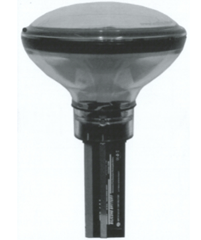An Australian first Key Logic on appealing from the Designs Office
21 June 2021

21 June 2021

Mr Arieni and Mr Fry were both directors of Exlites Pty Ltd.
Mr Arieni created an improved design for solar bollards, which was registered in the name of Exlites (Design No. 201012310) (Design). Extracted below is one of the representations of the Design:

Exlites was placed into administration in 2013. Prior to the administration, Mr Fry and Exlites transferred its intellectual property rights, including the Design, to an intermediary entity and then Key Logic (the appellant in this case, and a company controlled by the designer, Mr Arieni).
This is not the first Federal Court decision arising from these events. In Key Logic v Blue Groper Investments (2019) 367 ALR 507, the Federal Court considered allegations of copyright infringement and breaches of the Australian Consumer Law. You can read our summary of that case, here.
In February 2015, Sun-Wizard (the respondent to this case, and an entity of which Mr Fry is a director) made a third party request to the Registrar of Designs to examine the Design.
Sun-Wizard included supporting material with its request relating to publications by or on behalf of Exlites, including:
The Registrar of Designs found that the May 2010 email formed part of the prior art base, and rendered the Design not "new and distinctive" ([2017] ADO 8).
Key Logic appealed the Registrar's decision to the Federal Court.
This case is quite significant as it appears to be the first Federal Court judgment arising from an appeal from a decision of the Registrar of Designs (see [33]).
In that context, Justice Greenwood helpfully clarified that:
The key questions before Justice Greenwood were whether the Design was new and distinctive as against the prior art base, which included the earlier GENI product, and whether the May 2010 email even formed part of the prior art or was confidential.
Justice Greenwood applied the ubiquitous s 19 of the Act, and cited conventional authorities for its application (at [21]-[23]). It is of some interest that Justice Greenwood did not refer to Multisteps Pty Ltd v Source and Sell Pty Ltd [2013] FCA 743, nor Hunter Pacific International Pty Ltd v Martec Pty Ltd (2016) 121 IPR 1, being prominent recent cases on applying the somewhat difficult factors of s 19. However, this may only reflect and reinforce that the analysis is heavily fact dependent, and there may be limited utility in reasoning by analogy to the fact-dependent outcomes in other cases.
Justice Greenwood considered the voluminous evidence from the parties, and concluded that the visual features of the Design were not substantially similar in overall impression to the GENI design (at [135]).
In relation to the May 2010 email, Key Logic accepted that the attachments to the email disclosed the Design. The priority date of the Design is June 2010 and so, if the email formed part of the prior art base, it would render the Design not new and distinctive. However, Key Logic argued that the recipients of the email were under an obligation of confidence, and so the disclosure was not part of the prior art base.
Justice Greenwood accepted this, concluding that the recipients of the email were members of the Certified Installer Network of Exlites, who derived financial advantage from being members and some of whom had executed formal confidentiality agreements (although the evidence on this was not as strong as it might otherwise have been, with many alleged agreements unable to be located, and some may consider that Key Logic has been lucky to succeed in this case). Justice Greenwood also concluded that the information regarding the GENII product was inherently confidential (at [284]). Interestingly, Justice Greenwood considered that the email footer, which contained a standard disclaimer that its contents were confidential, was not determinative and instead "operated as a cognitive cue of some importance" (at [284(16)]).
Justice Greenwood concluded that the May 2010 email was confidential, and so did not form part of the prior art base, and therefore Design was new and distinctive.
The decision of the Registrar was delivered in October 2017. Key Logic filed its Federal Court appeal in November 2017. The hearing took place across three days in May 2019 and judgment was ultimately delivered in March 2021 – over three years after Key Logic filed the appeal.
There is some irony in the fact that the design in dispute reached its 10 year term and ceased on 7 June 2020, during the period between hearing and judgment.
Authors: Tim Rankin, Senior Associate and Kellech Smith, Partner.
The information provided is not intended to be a comprehensive review of all developments in the law and practice, or to cover all aspects of those referred to.
Readers should take legal advice before applying it to specific issues or transactions.








Sign-up to select your areas of interest
Sign-up